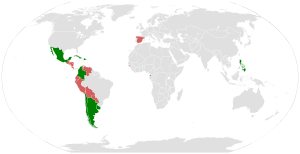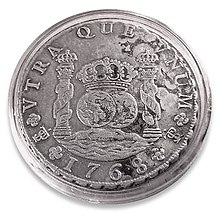Weight (currency)
The peso (symbols: $ in America and ₱ in the Philippines) is the name of the legal tender of seven countries of America (Argentina, Chile, Colombia, Cuba, Mexico, the Dominican Republic and Uruguay) and the Philippines. All pesos are minted in their respective countries and have different values. The peso is also the old Spanish silver coin of one ounce and value 8 reales, from which the current Spanish American and Philippine coins come. Its origin dates back to a Spanish monetary reform of 1497, which created the aforementioned duro or real peso of 8 among various currencies.
History
In Spanish America, a silver coin called peso, equivalent to 8 reales, was minted for the first time in 1536. It weighed 27 grams (one ounce) and read 0.92 o that it was 92% pure silver. It had been widely circulated since the 16th century, not only in Spanish America, but also in the European colonies of the continent.
In Mexico, the first viceroy Antonio de Mendoza, who arrived in 1535, carried with him a royal decree in which the Spanish Crown ordered the foundation of the first Mint in America, which minted pesos from 1536.
During the period of the conquest there was very little or no coin minted in the Spanish Indies. In Peru there was none, except the discs coarsely forged by the conquerors, until a Coin House was founded in Lima in 1565. The coin was scarce on the peninsula where payments were often made by cutting links from a gold chain. Spain did not send silver or gold to the Indies. Thus during the Conquest the payments were made weight and everywhere the balance had to be carried. The weight unit was the Spanish most commonly called gold weight and sometimes only weight, should not be confused with the silver back "Weight to eight" that came to have half the value of gold. The "castellano" or gold weight was a coin that had the weight of the hundredth part of a pound of fine gold. When the "castellano" stopped minting in 1497, it remained as a weight unit in the payment.F. A. Kirkpatrick: The Spanish conquerorschapter "The Money"
The Spanish peso was also the legal tender in the United States from 1785 to 1857, where it was usually known as the Spanish dollar. Because of this, the symbol $ of the Spanish peso is also the symbol of the US dollar as it derives from that. The symbol is the Pillars of Hercules and the band with the inscription "Plus Ultra" that appeared on that coin (and continued to appear on the one hundred pesetas coins, forming part of the royal coat of arms, until its disappearance with the entry of the euro).
After the independence of Spanish America, it remained the basic currency. With the adoption of the decimal system (that is, a peso divided into one hundred cents, cents or hundredths), some countries in the Americas changed their name:
- Balboa in Panama.
- Bolivar in Venezuela,
- Bolivian in Bolivia
- Colon in Costa Rica,
- Colon en El Salvador,
- Cordoba in Nicaragua,
- Guaraní in Paraguay,
- Lempira in Honduras
- Quetzal in Guatemala,
- Sucre in Ecuador,
- Sun in Peru.
Countries currently using the peso
Countries that use the weight with their ISO 4217 code:
- Argentina: Argentine peso (ARS).
- Chile: Chilean Peso (CLP).
- Colombia: Colombian Peso (COP).
- Cuba: Cuban peso (CUP)
- Philippines: Philippine peso (PHP).
- Mexico: Mexican Peso (MXN).
- Dominican Republic: Dominican Peso (DOP).
- Uruguay: Uruguayan peso (UYU).
Countries that historically used the peso
The peso was the currency of:
- Equatorial Guinea
- Bolivia, Bolivian peso between 1963 and 1988.
- Costa Rica, Costa Rican peso between 1821 and 1896.
- Ecuador, Ecuadorian peso between 1871 and 1884.
- El Salvador, Salvadoran peso between 1877 and 1892.
- Guatemala, Guatemalan peso between 1859 and 1925.
- Guinea-Bisáu, Weight of Guinea-Bisáu from 1975 to 1997.
- Honduras, Honduran peso between 1862 and 1931.
- Nicaragua, Nicaraguan peso between 1878 and 1912.
- Paraguay, Paraguayan peso between 1856 and 1944.
- Peru, Peruvian peso between 1822 and 1891.
- Puerto Rico, Puerto Rican Weight between 1812 and 1917.
- Venezuela, Venezuelan peso between 1821 and 1871.
Contenido relacionado
821
379
139

